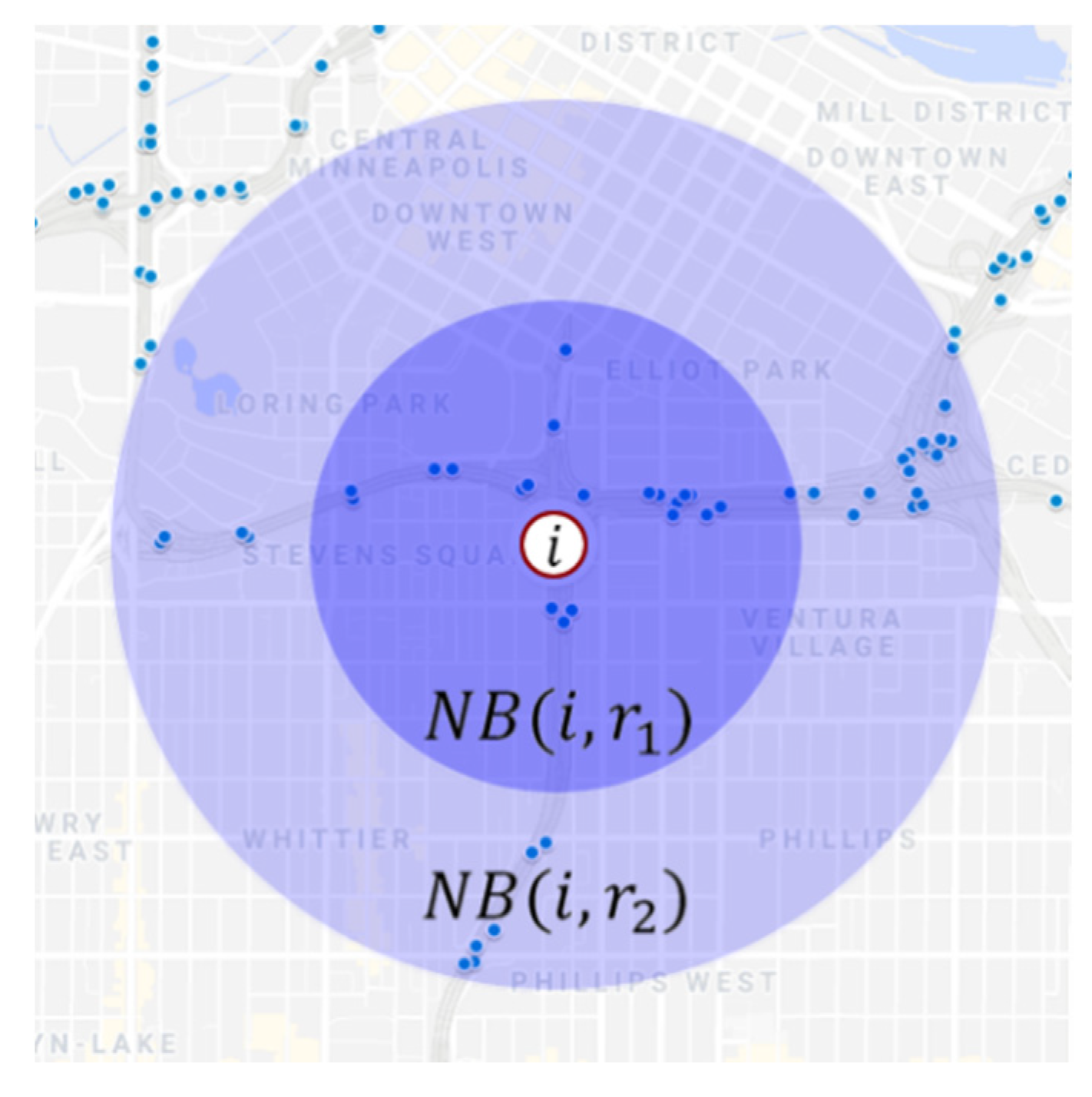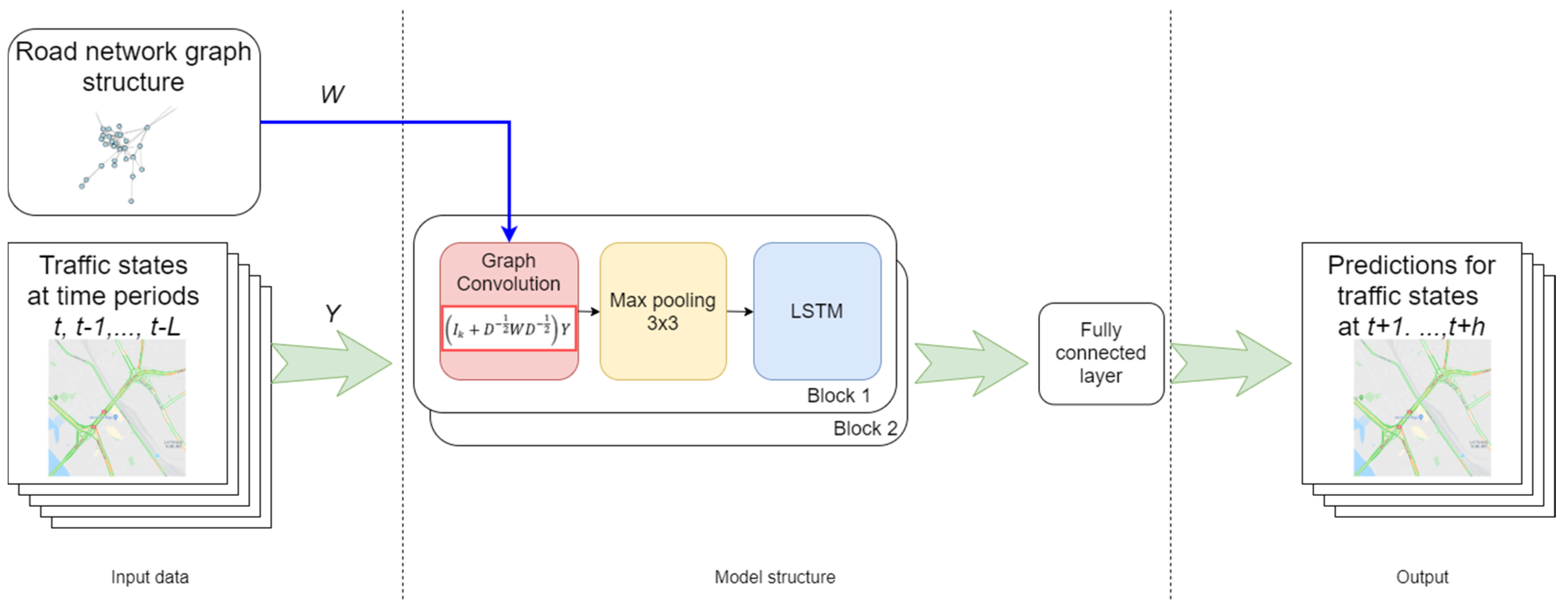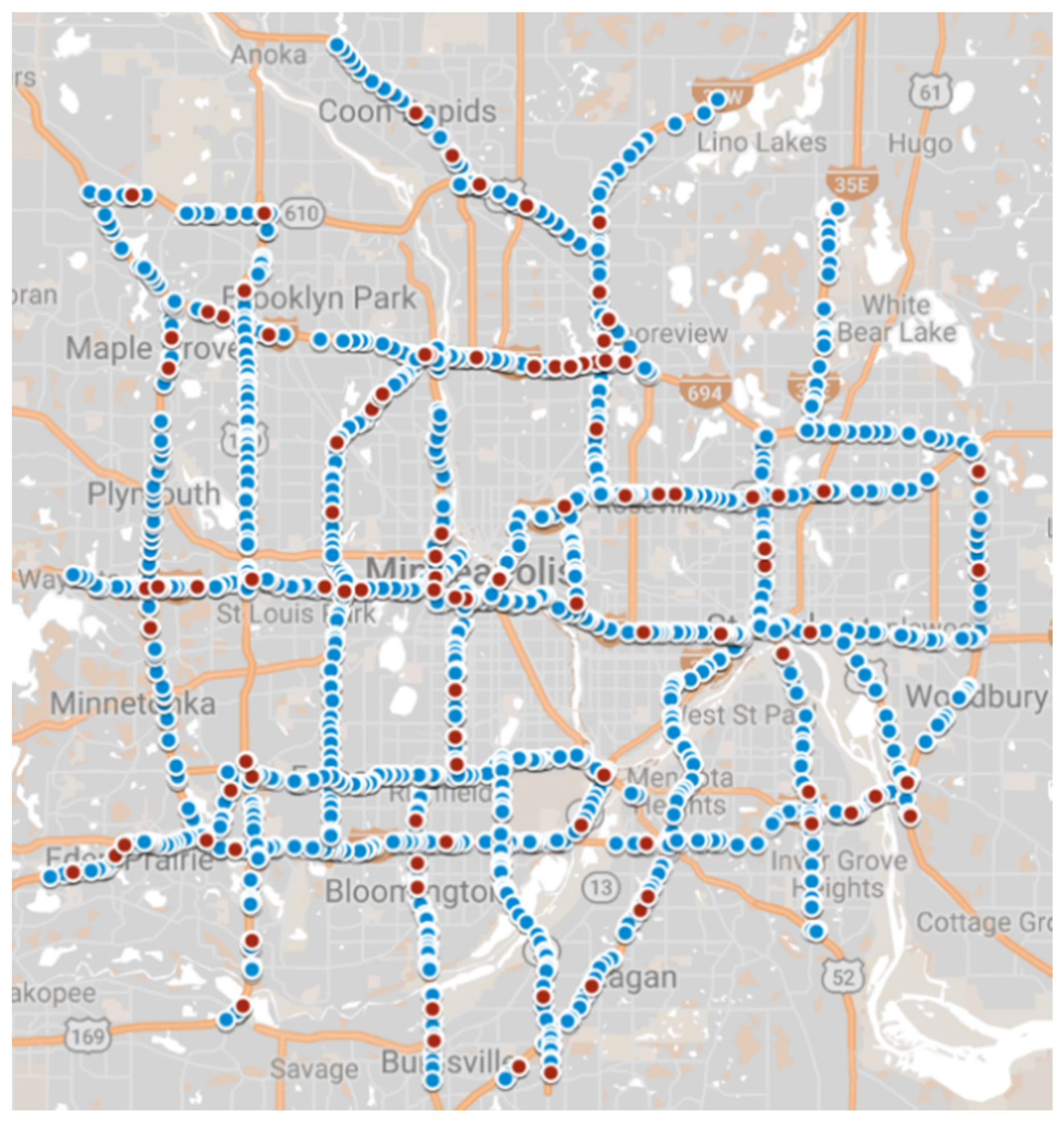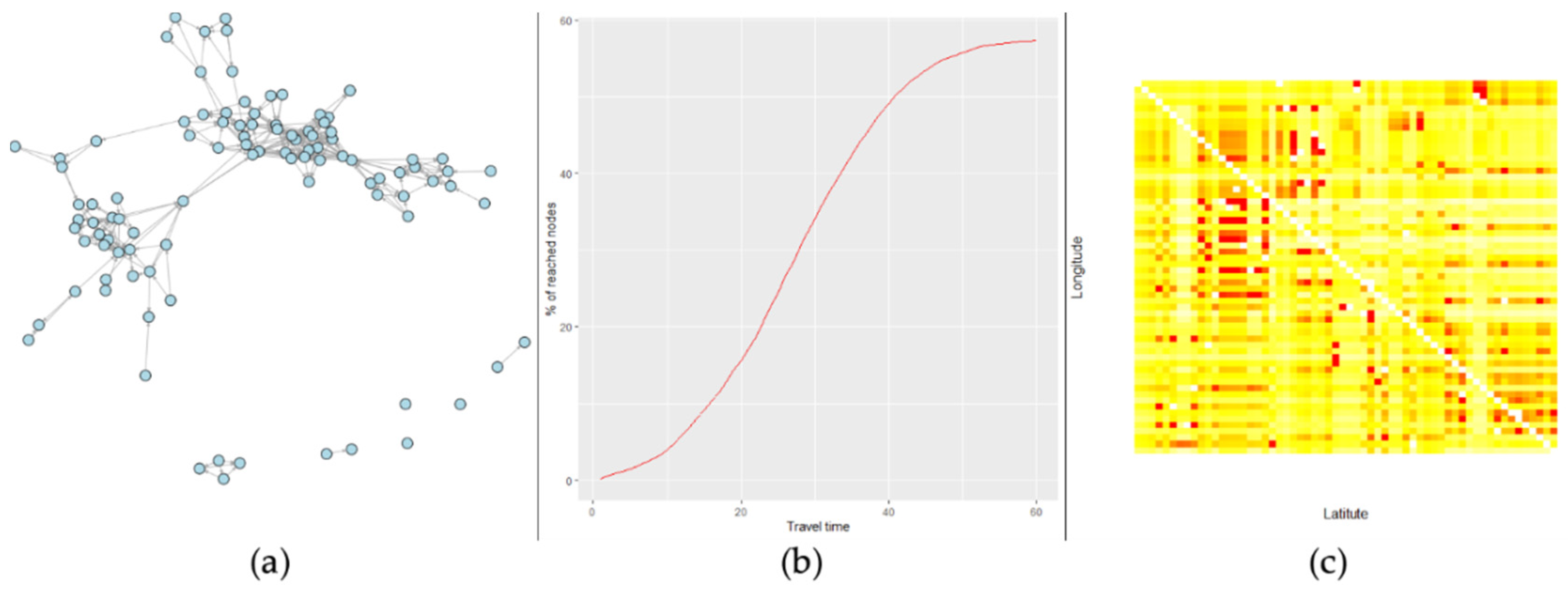Transfer Learning: Video Prediction and Spatiotemporal Urban Traffic Forecasting †
Abstract
1. Introduction
2. Literature Review
2.1. Video Prediction Methodology
2.2. Spatiotemporal Urban Traffic Forecasting Methodology
2.3. Transferring Methodologies between Video Prediction and Spatiotemporal Urban Traffic Forecasting
3. Methodology
3.1. Transferred Models
- Spatial filtering by predefined kernels (SpX-model), both pure and in combination with the time series model (SpX-ARIMAX), and,
- Graph-based convolutional ANN (GCNN).
3.1.1. Models Based on Spatial Kernels
3.1.2. Models Based on Graph Convolution
3.2. Baseline Models
- Naïve forecasts,
- Conventional ARIMA models,
- Conventional VAR models,
- Sparse VAR models in two specifications: with sparsity, controlled using travel time or cross-correlation.
4. Experimental Results
4.1. Data Set
- Lane detectors’ values are aggregated by road.
- Values are aggregated in 5-min time intervals, widely used for short-term traffic forecasting.
- Median traffic values are calculated for the first 30 weeks for every 5-min time interval and node, and used as periodical patterns of traffic flows.
- Obtained periodical patterns are subtracted from the flow values for the latest 10 weeks of the data set. As a result, we obtained detrended time series that are used for model training and testing. Thus, the models are focused on the forecasting of deviations from regular traffic conditions (in video prediction, this operation corresponds to the removal of a static background scene).
- Outliers are identified using detector- and time period-specific interquartile ranges. The selected threshold value is selected as 0.01 and is fairly small, so only wrong observations are filtered out, while real traffic values for congested conditions are kept in place. The identified outliers are marked as missed values.
- Linear interpolation is utilized for the imputation of missed values; detectors with more than 4 h of missed values in a row are excluded from the final data set.
- 100 detectors are randomly sampled from the complete data set for computational reasons.
4.2. Hyperparameter Tuning and Forecasting Accuracy
- Radii of spatial neighborhoods , and the spatial inflation for SpX-lm, SpX-SVR, and SpX-ARIMAX models;
- Spatial weights’ definition and distance decay parameter for SpX and GCNN models;
- ARIMA orders for conventional ARIMA and SpX-ARIMAX models, tuned by Hyndman and Khandakar’s algorithm [56];
- Cross-correlation threshold for SpVAR-cc model;
- Order p for VAR, SpVAR-tt, and SpVAR-cc models;
- Size of the rolling window (the look-back interval) L for all models (gradually increased until the models’ forecasting performance metrics are stabilized).
4.3. Estimation Results
4.4. Reproducibility
5. Discussion
6. Conclusions
Funding
Acknowledgments
Conflicts of Interest
References
- Pavlyuk, D. Spatiotemporal Traffic Forecasting as a Video Prediction Problem. In Proceedings of the 2019 6th International Conference on Models and Technologies for Intelligent Transportation Systems (MT-ITS), Cracow, Poland, 5–7 June 2019; pp. 1–7. [Google Scholar]
- Weiss, K.; Khoshgoftaar, T.M.; Wang, D. A survey of transfer learning. J. Big Data 2016, 3, 9. [Google Scholar] [CrossRef]
- Qi, G.-J.; Aggarwal, C.; Huang, T. Towards semantic knowledge propagation from text corpus to web images. In Proceedings of the 20th International Conference on World Wide Web—WWW ’11, Hyderabad, India, 28 March–1 April 2011; ACM Press: Hyderabad, India, 2011; pp. 297–306. [Google Scholar]
- Oquab, M.; Bottou, L.; Laptev, I.; Sivic, J. Learning and Transferring Mid-level Image Representations Using Convolutional Neural Networks. In Proceedings of the 2014 IEEE Conference on Computer Vision and Pattern Recognition, Columbus, OH, USA, 23–28 June 2014; pp. 1717–1724. [Google Scholar]
- Shi, X.; Liu, Q.; Fan, W.; Yu, P.S.; Zhu, R. Transfer Learning on Heterogenous Feature Spaces via Spectral Transformation. In Proceedings of the 2010 IEEE International Conference on Data Mining, Sydney, Australia, 13–17 December 2010; pp. 1049–1054. [Google Scholar]
- Tekalp, A.M. Digital Video Processing, 2nd ed.; Prentice Hall: New York, NY, USA, 2015; ISBN 978-0-13-399100-0. [Google Scholar]
- Ermagun, A.; Levinson, D. Spatiotemporal traffic forecasting: Review and proposed directions. Trans. Rev. 2018, 38, 786–814. [Google Scholar] [CrossRef]
- Pavlyuk, D. Feature selection and extraction in spatiotemporal traffic forecasting: A systematic literature review. Eur. Trans. Res. Rev. 2019, 11, 6. [Google Scholar] [CrossRef]
- Najim, M. Digital Filters Design for Signal and Image Processing; John Wiley & Sons: Hoboken, JA, USA, 2006. [Google Scholar]
- Ohashi, O.; Torgo, L. Spatial Interpolation Using Multiple Regression. In Proceedings of the 2012 IEEE 12th International Conference on Data Mining, Brussels, Belgium, 10–13 December 2012; pp. 1044–1049. [Google Scholar]
- Hutchison, D.; Kanade, T.; Kittler, J.; Kleinberg, J.M.; Mattern, F.; Mitchell, J.C.; Naor, M.; Nierstrasz, O.; Pandu Rangan, C.; Steffen, B.; et al. Non-Local Kernel Regression for Image and Video Restoration. In Computer Vision—ECCV 2010; Daniilidis, K., Maragos, P., Paragios, N., Eds.; Springer: Berlin/Heidelberg, Germany, 2010; Volume 6313, pp. 566–579. ISBN 978-3-642-15557-4. [Google Scholar]
- Sutskever, I.; Hinton, G. Learning Multilevel Distributed Representations for High-Dimensional Sequences. In Proceedings of the Eleventh International Conference on Artificial Intelligence and Statistics, San Juan, Puerto Rico, 21–24 March 2007; pp. 548–555. [Google Scholar]
- Verma, N.K. Future image frame generation using Artificial Neural Network with selected features. In Proceedings of the 2012 IEEE Applied Imagery Pattern Recognition Workshop (AIPR), Washington, DC, USA, 9–11 October 2012; pp. 1–8. [Google Scholar]
- Barron, J.L.; Fleet, D.J.; Beauchemin, S.S. Performance of optical flow techniques. Int. J. Comput. Vision 1994, 12, 43–77. [Google Scholar] [CrossRef]
- Sakaino, H. Spatio-Temporal Image Pattern Prediction Method Based on a Physical Model with Time-Varying Optical Flow. IEEE Trans. Geosci. Remote Sens. 2013, 51, 3023–3036. [Google Scholar] [CrossRef]
- Verma, N.K. Shimaila Generation of Future image frames using Adaptive Network Based Fuzzy Inference System on spatiotemporal framework. In Proceedings of the 2012 IEEE Applied Imagery Pattern Recognition Workshop (AIPR), Washington, DC, USA, 9–11 October 2012; pp. 1–8. [Google Scholar]
- Lotter, W.; Kreiman, G.; Cox, D. Deep Predictive Coding Networks for Video Prediction and Unsupervised Learning. In Proceedings of the 5th International Conference on Learning Representations (ICLR 2017), Toulon, France, 24–26 April 2017; p. 18. [Google Scholar]
- Villegas, R.; Yang, J.; Hong, S.; Lin, X.; Lee, H. Decomposing Motion and Content for Natural Video Sequence Prediction. In Proceedings of the 5th International Conference on Learning Representations (ICLR 2017), Toulon, France, 24–26 April 2017; p. 22. [Google Scholar]
- Vondrick, C.; Pirsiavash, H.; Torralba, A. Generating Videos with Scene Dynamics. In Advances in Neural Information Processing Systems 29; Lee, D.D., Sugiyama, M., Luxburg, U.V., Guyon, I., Garnett, R., Eds.; Curran Associates, Inc.: Dakis, NY, USA, 2016; pp. 613–621. [Google Scholar]
- Liang, X.; Lee, L.; Dai, W.; Xing, E.P. Dual Motion GAN for Future-Flow Embedded Video Prediction. In Proceedings of the 2017 IEEE International Conference on Computer Vision (ICCV), Venice, Italy, 22–29 October 2017; pp. 1762–1770. [Google Scholar]
- Wang, Y.; Long, M.; Wang, J.; Gao, Z.; Yu, P.S. PredRNN: Recurrent Neural Networks for Predictive Learning using Spatiotemporal LSTMs. In Advances in Neural Information Processing Systems 30; Guyon, I., Luxburg, U.V., Bengio, S., Wallach, H., Fergus, R., Vishwanathan, S., Garnett, R., Eds.; Curran Associates, Inc.: Dakis, NY, USA, 2017; pp. 879–888. [Google Scholar]
- Zhang, S.; Tong, H.; Xu, J.; Maciejewski, R. Graph convolutional networks: A comprehensive review. Comput. Soc. Netw. 2019, 6, 11. [Google Scholar] [CrossRef]
- Bhattacharjee, P.; Das, S. Directional Attention based Video Frame Prediction using Graph Convolutional Networks. In Proceedings of the 2019 International Joint Conference on Neural Networks (IJCNN), Budapest, Hungary, 14–19 July 2019; pp. 1–10. [Google Scholar]
- Li, B.; Li, X.; Zhang, Z.; Wu, F. Spatio-Temporal Graph Routing for Skeleton-Based Action Recognition. In Proceedings of the Thirty-Third AAAI Conference on Artificial Intelligence (AAAI-19), Honolulu, HI, USA, 27 January–1 February 2019; Volume 33, pp. 8561–8568. [Google Scholar]
- Shi, L.; Zhang, Y.; Cheng, J.; Lu, H. Two-Stream Adaptive Graph Convolutional Networks for Skeleton-Based Action Recognition. In Proceedings of the 2019 IEEE/CVF Conference on Computer Vision and Pattern Recognition (CVPR), Long Beach, CA, USA, 15–21 June 2019; p. 10. [Google Scholar]
- Lighthill, M.J.; Whitham, G.B. On kinematic waves II. A theory of traffic flow on long crowded roads. Proc. R. Soc. Lond. Ser. A Math. Phys.Sci. 1955, 229, 317–345. [Google Scholar]
- Velasco, R.M.; Marques, W. Navier-Stokes-like equations for traffic flow. Phys. Rev. E 2005, 72, 046102. [Google Scholar] [CrossRef]
- Ahmed, M.S.; Cook, A.R. Analysis of freeway traffic time series data by using Box-Jenkins techniques. Trans. Res. Rec. 1979, 722, 1–9. [Google Scholar]
- Okutani, I.; Stephanedes, Y.J. Dynamic prediction of traffic volume through Kalman filtering theory. Trans. Res. Part B Methodol. 1984, 18, 1–11. [Google Scholar] [CrossRef]
- Williams, B. Multivariate vehicular traffic flow prediction: Evaluation of ARIMAX modeling. Trans. Res. Rec. J. Trans. Res. Board 2001, 1776, 194–200. [Google Scholar] [CrossRef]
- Li, L.; Su, X.; Wang, Y.; Lin, Y.; Li, Z.; Li, Y. Robust causal dependence mining in big data network and its application to traffic flow predictions. Trans. Res. Part C Emerg. Technol. 2015, 58, 292–307. [Google Scholar] [CrossRef]
- Ermagun, A.; Levinson, D.M. Development and application of the network weight matrix to predict traffic flow for congested and uncongested conditions. Environ. Plan. B Urban Anal. City Sci. 2018, 46, 1684–1705. [Google Scholar] [CrossRef]
- Kamarianakis, Y.; Prastacos, P. Forecasting Traffic Flow Conditions in an Urban Network: Comparison of Multivariate and Univariate Approaches. Trans. Res. Rec. J. Trans. Res. Board 2003, 1857, 74–84. [Google Scholar] [CrossRef]
- Salamanis, A.; Kehagias, D.D.; Filelis-Papadopoulos, C.K.; Tzovaras, D.; Gravvanis, G.A. Managing Spatial Graph Dependencies in Large Volumes of Traffic Data for Travel-Time Prediction. IEEE Trans. Intell. Trans. Syst. 2016, 17, 1678–1687. [Google Scholar] [CrossRef]
- Kamarianakis, Y.; Shen, W.; Wynter, L. Real-time road traffic forecasting using regime-switching space-time models and adaptive LASSO. Appl. Stoch. Models Bus. Ind. 2012, 28, 297–315. [Google Scholar] [CrossRef]
- Clark, S.D.; Dougherty, M.S.; Kirby, H.R. The use of neural networks and time series models for short term traffic forecasting: A comparative study. In Proceedings of the PTRC European Transport, Highways and Planning 21st Summer Annual Meeting, Manchester, UK, 13–17 September 1993; pp. 151–162. [Google Scholar]
- Park, D.; Rilett, L.R. Forecasting freeway link travel times with a multilayer feedforward neural network. Computer-Aided Civ. Infrastruct. Eng. 1999, 14, 357–367. [Google Scholar] [CrossRef]
- van Lint, J.W.C.; Hoogendoorn, S.P.; van Zuylen, H.J. Accurate freeway travel time prediction with state-space neural networks under missing data. Trans. Res. Part C Emerg. Technol. 2005, 13, 347–369. [Google Scholar] [CrossRef]
- Abdulhai, B.; Porwal, H.; Recker, W. Short-Term Traffic Flow Prediction Using Neuro-Genetic Algorithms. J. Intell. Trans. Syst. 2002, 7, 3–41. [Google Scholar] [CrossRef]
- Huang, W.; Song, G.; Hong, H.; Xie, K. Deep Architecture for Traffic Flow Prediction: Deep Belief Networks With Multitask Learning. IEEE Trans. Intell. Trans. Syst. 2014, 15, 2191–2201. [Google Scholar] [CrossRef]
- Cao, Q.; Ren, G.; Li, D. Multiple Spatio-temporal Scales Traffic Forecasting Based on Deep Learning Approach. In Proceedings of the Compendium of Papers of the Transportation Research Board 97th Annual Meeting, Washington, DC, USA, 7–11 January 2018; p. 18. [Google Scholar]
- Liang, Y.; Cui, Z.; Tian, Y.; Chen, H.; Wang, Y. A Deep Generative Adversarial Architecture for Network-wide Spatial-Temporal Traffic State Estimation. In Proceedings of the Transportation Research Board 97th Annual Meeting, Washington, DC, USA, 7–11 January 2018; p. 22. [Google Scholar]
- Cui, Z.; Henrickson, K.; Ke, R.; Wang, Y. Traffic Graph Convolutional Recurrent Neural Network: A Deep Learning Framework for Network-Scale Traffic Learning and Forecasting. IEEE Trans. Intell. Trans. Syst. 2019, 1–12. [Google Scholar] [CrossRef]
- Yu, B.; Yin, H.; Zhu, Z. Spatio-Temporal Graph Convolutional Networks: A Deep Learning Framework for Traffic Forecasting. In Proceedings of the Twenty-Seventh International Joint Conference on Artificial Intelligence, Stockholm, Sweden, 13–19 July 2018; pp. 3634–3640. [Google Scholar]
- Zhang, Q.; Jin, Q.; Chang, J.; Xiang, S.; Pan, C. Kernel-Weighted Graph Convolutional Network: A Deep Learning Approach for Traffic Forecasting. In Proceedings of the 2018 24th International Conference on Pattern Recognition (ICPR), Beijing, China, 20–24 August 2018; pp. 1018–1023. [Google Scholar]
- Ma, X.; Dai, Z.; He, Z.; Ma, J.; Wang, Y.; Wang, Y. Learning Traffic as Images: A Deep Convolutional Neural Network for Large-Scale Transportation Network Speed Prediction. Sensors 2017, 17, 818. [Google Scholar] [CrossRef]
- Yu, H.; Wu, Z.; Wang, S.; Wang, Y.; Ma, X. Spatiotemporal Recurrent Convolutional Networks for Traffic Prediction in Transportation Networks. Sensors 2017, 17, 1501. [Google Scholar] [CrossRef]
- Krishnakumari, P.; Perotti, A.; Pinto, V.; Cats, O.; van Lint, H. Understanding Network Traffic States using Transfer Learning. In Proceedings of the 2018 21st International Conference on Intelligent Transportation Systems (ITSC), Maui, HI, USA, 4–7 November 2018; pp. 1396–1401. [Google Scholar]
- Pavlyuk, D. Make It Flat: Multidimensional Scaling of Citywide Traffic Data. In RelStat 2019: Reliability and Statistics in Transportation and Communication; Kabashkin, I., Jackiva, I., Prentkovskis, O., Eds.; Springer International Publishing: Cham, Switzerland, 2020; in press. [Google Scholar]
- Drucker, H.; Burges, C.J.C.; Kaufman, L.; Smola, A.J.; Vapnik, V. Support Vector Regression Machines. In Advances in Neural Information Processing Systems 9; Mozer, M.C., Jordan, M.I., Petsche, T., Eds.; MIT Press: Cambridge, MA, USA, 1997; pp. 155–161. [Google Scholar]
- Lin, B.Y.; Xu, F.F.; Liao, E.Q.; Zhu, K.Q. Transfer Learning for Traffic Speed Prediction with Effective Spatiotemporal Features. In Proceedings of the 31st Conference on Neural Information Processing Systems (NIPS 2017), Long Beach, CA, USA, 4–9 December 2017; p. 7. [Google Scholar]
- Bruna, J.; Zaremba, W.; Szlam, A.; Lecun, Y. Spectral networks and locally connected networks on graphs. In Proceedings of the International Conference on Learning Representations (ICLR2014), Banff, AB, Canada, 14–16 April 2014; p. 14. [Google Scholar]
- Micheli, A. Neural Network for Graphs: A Contextual Constructive Approach. IEEE Trans. Neural Netw. 2009, 20, 498–511. [Google Scholar] [CrossRef]
- Schimbinschi, F.; Moreira-Matias, L.; Nguyen, V.X.; Bailey, J. Topology-regularized universal vector autoregression for traffic forecasting in large urban areas. Expert Syst. Appl. 2017, 82, 301–316. [Google Scholar] [CrossRef]
- Zivot, E.; Wang, J. Rolling Analysis of Time Series. In Modeling Financial Time Series with S-PLUS; Springer: New York, NY, USA, 2006; pp. 313–360. ISBN 978-0-387-27965-7. [Google Scholar]
- Hyndman, R.J.; Khandakar, Y. Automatic Time Series Forecasting: The forecast Package for R. J. Stat. Softw. 2008, 27. [Google Scholar] [CrossRef]
- Kwon, T. RTMC *. Traffic Data. Available online: http://www.d.umn.edu/~tkwon/TMCdata/TMCarchive.html (accessed on 12 January 2018).





| Feature | Video Prediction | Spatiotemporal Urban Traffic Forecasting |
|---|---|---|
| Data structure | ||
| Observation | Pixel | Road segment |
| Spatial setting | Video frame | Citywide road network |
| Temporal setting | Sequence of video frames | Sequence of temporally aggregated traffic states |
| Modeled variable | Multiple channels for every pixel (e.g., Red, Green, Blue) | Multiple traffic flow characteristics (e.g., flow value, speed, occupancy) |
| Problem dimension | Huge spatial and temporal dimensions (e.g., 1920 × 1080 resolution of 24 frames per second) | Huge spatial and temporal dimensions (e.g., thousands of road segments in a medium-sized city with 30-s aggregation) |
| Data availability | Data-rich area | Data-rich area |
| Dependencies | Spatiotemporal graph | Spatiotemporal graph |
| Methodology | ||
| Type | Spatiotemporal | Spatiotemporal |
| Forecasting features | Separate prediction of stable regions (backward scene) and dynamic objects (motion) | Separate prediction of normal and abnormal traffic conditions (congestion) |
| Attention | Dynamic objects (recognition and prediction of motion) | Dynamic “objects” (congestion and prediction of its growth) |
| Physical analogies | Physics of observed process (e.g., optical flow models) | Analogy with physics of fluids (e.g., kinematic macroscopic traffic flow models) |
| Potential grouping | Patches (stable regions of a video frame) | Clusters (road segments with similar traffic flows) or reservoirs |
| Emerging approaches | Graph-based convolutional ANN | Graph-based convolutional ANN; Multivariate time series with a graph-based structure of dependencies |
| Hyperparameter | Symbol | Tested Values | Used in Models |
|---|---|---|---|
| Radii of spatial neighborhoods | , | [0, 10, 20, 30] | SpX-lm, SpX-SVR, SpX-ARIMAX |
| Spatial inflation | [0, 5] | SpX-lm, SpX-SVR, SpX-ARIMAX | |
| Spatial weights | SpX-lm, SpX-SVR, SpX-ARIMAX, GCNN | ||
| Distance decay speed for | [10, 20] | GCNN | |
| Cross-correlation threshold | [0.1, 0.2, 0.3] | SpVAR-cc | |
| Order of autoregression and moving average components | p, q | Hyndman and Khandakar’s algorithm [56] | ARIMA, SpX-ARIMAX |
| Order of autoregression | p | [1, 3, 6] | VAR, SpVAR-tt, SpVAR-cc |
| Look-back interval | L | [360, 720, 1440] | All models |
| Model | Calibrated Hypermeters’ Values | MAE by Forecasting Horizon | RMSE by Forecasting Horizon | ||||
|---|---|---|---|---|---|---|---|
| 0–5 min (h = 1) | 5–10 min (h = 2) | 10–15 min (h = 3) | 0–5 min (h = 1) | 5–10 min (h = 2) | 10–15 min (h = 3) | ||
| Transferred models | |||||||
| SpX-lm | 11.27 | 11.68 | 11.90 | 16.42 | 17.04 | 17.41 | |
| SpX-SVR | 10.54 | 10.83 | 11.08 | 15.78 | 16.17 | 16.51 | |
| SpX-ARIMAX | 8.85 | 9.56 | 9.91 | 12.54 | 13.75 | 14.33 | |
| GCNN | 9.77 | 10.57 | 11.16 | 18.62 | 23.37 | 25.95 | |
| Baseline models | |||||||
| SpVAR-tt | - | 8.92 | 9.42 | 9.84 | 12.58 | 13.40 | 14.09 |
| SpVAR-cc | 8.88 | 9.35 | 9.80 | 12.51 | 13.27 | 14.02 | |
| VAR | 12.61 | 12.66 | 12.68 | 17.40 | 17.57 | 17.72 | |
| ARIMA | detector-specific p, q | 9.02 | 9.80 | 10.57 | 12.74 | 14.09 | 15.56 |
| Naïve | - | 16.21 | 16.59 | 16.83 | 25.37 | 25.85 | 26.26 |
© 2020 by the author. Licensee MDPI, Basel, Switzerland. This article is an open access article distributed under the terms and conditions of the Creative Commons Attribution (CC BY) license (http://creativecommons.org/licenses/by/4.0/).
Share and Cite
Pavlyuk, D. Transfer Learning: Video Prediction and Spatiotemporal Urban Traffic Forecasting. Algorithms 2020, 13, 39. https://doi.org/10.3390/a13020039
Pavlyuk D. Transfer Learning: Video Prediction and Spatiotemporal Urban Traffic Forecasting. Algorithms. 2020; 13(2):39. https://doi.org/10.3390/a13020039
Chicago/Turabian StylePavlyuk, Dmitry. 2020. "Transfer Learning: Video Prediction and Spatiotemporal Urban Traffic Forecasting" Algorithms 13, no. 2: 39. https://doi.org/10.3390/a13020039
APA StylePavlyuk, D. (2020). Transfer Learning: Video Prediction and Spatiotemporal Urban Traffic Forecasting. Algorithms, 13(2), 39. https://doi.org/10.3390/a13020039




